Ancient Roman architecture wasn't just about impressive buildings; it was a powerful tool in politics, used to showcase strength and control. From grand forums to monumental arches, the construction projects reflected the authority of their commissioners and communicated messages of power. Understanding this connection helps us see how architecture can influence society and even guide political landscapes. In Rome, every stone and column had a political story to tell, painting a vivid picture of the empire's ambitions.
Roman politics: how power shaped Rome’s buildings and public life
Roman politics wasn’t just speeches and senate debates. It was a hands-on force that decided which temples were built, which roads were paved, and who got to stand where in a public square. If you want to understand Roman architecture, you have to see buildings as political tools — monuments, meeting places, and workhouses all sent a message.
How Roman politics shaped public buildings
The main political players were the Senate, elected magistrates, and later the emperors. Senators and magistrates funded temples, basilicas, and forums to boost their status. Emperors used massive projects — aqueducts, baths, triumphal arches — to show strength and win public support. Think about the Forum Romanum: it grew with each generation, each new leader adding a building that shouted their name.
Public space was also control. Roads and aqueducts improved life, yes, but they tied people into the empire. Markets and basilicas managed trade and law. Amphitheaters and circuses kept the crowd entertained and distracted. Festivals, parades, and statue dedications were political theatre — the city planned these to shape opinion and loyalty.
Concrete examples and simple timelines
Augustus is a clear example. After years of civil war, he rebuilt Rome with temples, a new Forum, and public services. His projects mixed usefulness with clear propaganda: they fixed problems and linked his name to stability. Nero rebuilt parts of the city after a big fire, and later emperors like Trajan and Hadrian left huge monuments that pushed imperial identity across the provinces.
Buildings carried specific messages. Columns, inscriptions, and reliefs told stories of victories and divine favor. Temples suggested the ruler had the gods on their side. Triumphal arches recorded battles and leaders. Even housing was political: wealthy patrons built lavish domus to show their power, while the layout of insulae (apartment blocks) reflected city density and social class.
Politics also made rules for building: fire laws, street widths, and zoning came from political choices after big disasters or riots. Those rules changed how the city looked and how people moved through it.
Want to spot political intent when you visit ruins? Look for dedication inscriptions, recurring imperial names, and grand public programs like baths or forums. Notice where a statue faces, which road leads to a building, and how a space organizes crowds. Those small clues tell who wanted attention and why.
If you enjoy exploring architecture and history, reading Roman political context will change how you see every brick and column. Check articles on Roman building techniques, forums, and imperial programs to connect politics with the stones that still stand today.

